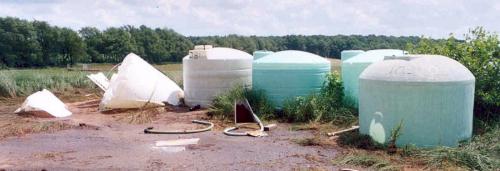Poly tank inspection techniques
Maintenance of polyethylene tanks is critical for safe use.
As spring activities begin, farmers are reminded that sprayers and tanks need to be inspected for damage or degradation. Calibration is the first and sometimes the only inspection that an applicator conducts on their sprayer. While this is necessary and recommended by Michigan Generally Accepted Agricultural and Management Practices, it is not the only aspect of spray equipment that requires regular inspection and maintenance.

Collapsed poly tanks. Photo credit: Jack Knorek, Michigan Department of Agriculture and Rural Development
Polyethylene tanks, or poly tanks for short, are extensively used on farms in Michigan. These tanks are very versatile and readily available. Depending on how they are used and the environmental conditions they are exposed to, poly tanks have a varied lifespan. Those used for chemicals and other caustic materials will eventually weaken and fail.
Tank integrity is measured by three indicators: scratches, crazing and cracks:
- Scratches are on the surface and can be seen and felt.
- Crazing is a network of fine lines or cracks that may look like a patchwork, but often cannot be seen with a visual inspection. Crazing can be seen when using one of the testing methods explained below. Crazing occurs within the tank wall and can be a sign of deterioration of the plastic, which may lead to cracks. Tanks that show signs of crazing will still hold liquids, but the integrity of the tank is questionable. For this reason, caution should be used when putting any hazardous substance in tanks that show crazing.
- Cracks extend through the plastic wall and can be visually seen and felt. Cracks may run parallel or at right angles to each other.
Testing poly tanks is a simple procedure. If you purchase a new tank you should fill it with water and let it set overnight to ensure that there are no leaks before putting any hazardous substance in it. Three different testing methods can be used on a tank that has been in use: candling, a water-soluble marker and the ever-popular bat method. Prior to employing any of these methods, first do a visual inspection looking for any scratches or surface damage:
- Candling is using light to visually inspect a tank. You will need a bright cool light for this procedure. The first step is to inspect the outside of the tank. Place a floodlight or very bright flashlight inside the tank while you look on the outside for any cracks or crazing. The next step is to inspect the inside of the tank. Place the light on the outside of the tank and have someone look through the fill opening. Do not allow anyone to put his or her head inside the tank. You may want to consider using a camera to safely complete the interior inspection from the top of the tank.
- Marking the tank with a water-soluble marker is a good, safe way to determine if your tank has integrity problems. This method will show you if your tank has crazing issues or cracks. Start by checking the areas that get the most UV, or sunlight, exposure. Rub a water-soluble marker in a six-inch by six-inch section and then quickly wipe it off with a dry paper towel or cloth. If there is any crazing or cracking, the ink will have penetrated the tank surface and will not rub off. Repeat this procedure in several locations on the tank. If the test reveals cracking or spider webbing with lines going in all directions, this is a sign of deterioration. Test a deteriorating tank often and, if possible, use it only for water. If the test reveals a checkered appearance, this is likely a sign of dry rot. Tanks with dry rot lose their ability to expand and become brittle. These tanks should be replaced or used only for water. If your tank shows parallel lines, this is an early sign of UV damage and the tank should be closely monitored. If parallel lines appear around the fittings, the tank should be replaced immediately or used exclusively for water.
- The third method for inspecting poly tanks is the bat method, which involves testing an empty tank’s brittleness by hitting it with a baseball bat. This method is the simplest and, depending on your temperament, the most therapeutic. This is a great method to check tanks that have cracking on them. A good poly tank is flexible and bends in and out as it is filled and emptied. Tanks that are brittle lose their ability to expand under pressure and to move when impacted.
Michigan State University Extension recommends inspecting every poly tank on your farm at least annually. Tank inspection is an easy way to protect your safety, your farm’s bottom line and the environment.



 Print
Print Email
Email
